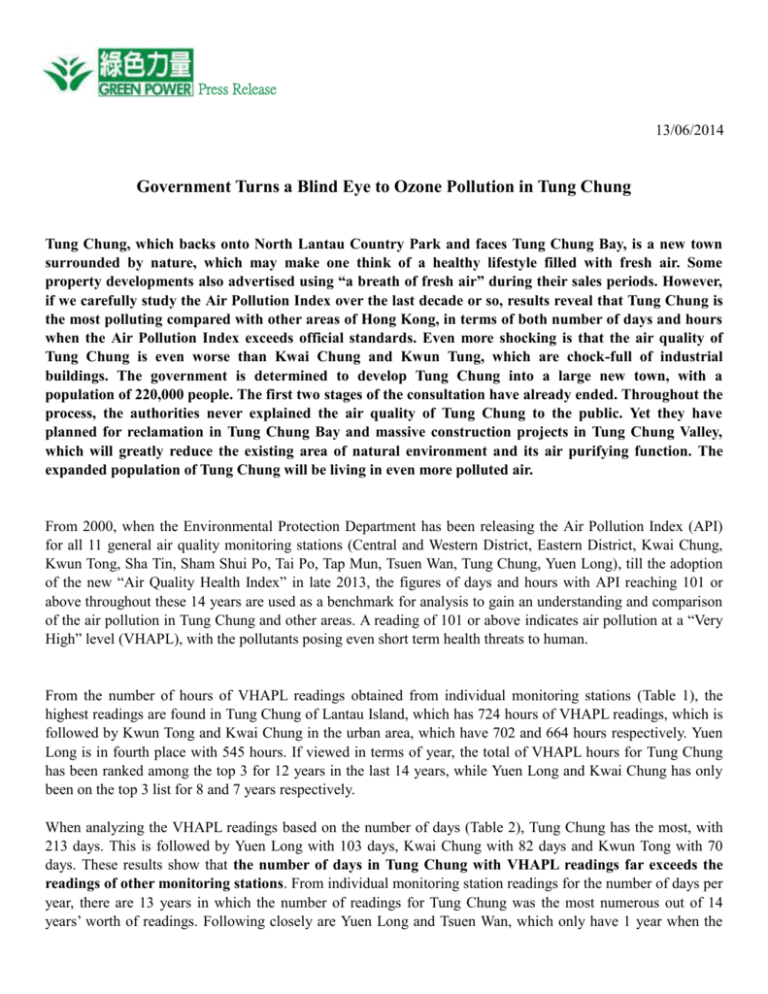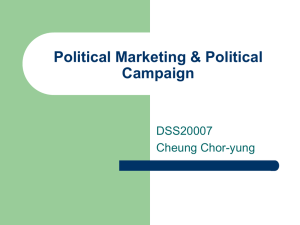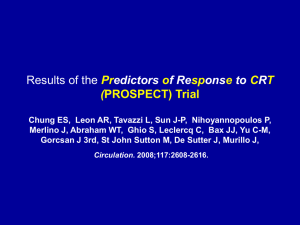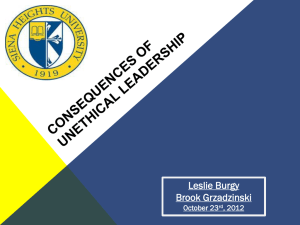Government Turns a Blind Eye to Ozone Pollution in Tung Chung
advertisement

Press Release Press Release 13/06/2014 Government Turns a Blind Eye to Ozone Pollution in Tung Chung Tung Chung, which backs onto North Lantau Country Park and faces Tung Chung Bay, is a new town surrounded by nature, which may make one think of a healthy lifestyle filled with fresh air. Some property developments also advertised using “a breath of fresh air” during their sales periods. However, if we carefully study the Air Pollution Index over the last decade or so, results reveal that Tung Chung is the most polluting compared with other areas of Hong Kong, in terms of both number of days and hours when the Air Pollution Index exceeds official standards. Even more shocking is that the air quality of Tung Chung is even worse than Kwai Chung and Kwun Tung, which are chock-full of industrial buildings. The government is determined to develop Tung Chung into a large new town, with a population of 220,000 people. The first two stages of the consultation have already ended. Throughout the process, the authorities never explained the air quality of Tung Chung to the public. Yet they have planned for reclamation in Tung Chung Bay and massive construction projects in Tung Chung Valley, which will greatly reduce the existing area of natural environment and its air purifying function. The expanded population of Tung Chung will be living in even more polluted air. From 2000, when the Environmental Protection Department has been releasing the Air Pollution Index (API) for all 11 general air quality monitoring stations (Central and Western District, Eastern District, Kwai Chung, Kwun Tong, Sha Tin, Sham Shui Po, Tai Po, Tap Mun, Tsuen Wan, Tung Chung, Yuen Long), till the adoption of the new “Air Quality Health Index” in late 2013, the figures of days and hours with API reaching 101 or above throughout these 14 years are used as a benchmark for analysis to gain an understanding and comparison of the air pollution in Tung Chung and other areas. A reading of 101 or above indicates air pollution at a “Very High” level (VHAPL), with the pollutants posing even short term health threats to human. From the number of hours of VHAPL readings obtained from individual monitoring stations (Table 1), the highest readings are found in Tung Chung of Lantau Island, which has 724 hours of VHAPL readings, which is followed by Kwun Tong and Kwai Chung in the urban area, which have 702 and 664 hours respectively. Yuen Long is in fourth place with 545 hours. If viewed in terms of year, the total of VHAPL hours for Tung Chung has been ranked among the top 3 for 12 years in the last 14 years, while Yuen Long and Kwai Chung has only been on the top 3 list for 8 and 7 years respectively. When analyzing the VHAPL readings based on the number of days (Table 2), Tung Chung has the most, with 213 days. This is followed by Yuen Long with 103 days, Kwai Chung with 82 days and Kwun Tong with 70 days. These results show that the number of days in Tung Chung with VHAPL readings far exceeds the readings of other monitoring stations. From individual monitoring station readings for the number of days per year, there are 13 years in which the number of readings for Tung Chung was the most numerous out of 14 years’ worth of readings. Following closely are Yuen Long and Tsuen Wan, which only have 1 year when the Press Release Press Release number VHAPL readings were the most numerous. This comes to show that Tung Chung has remained the monitoring station with the most days for recordings of 101 and over on the API. Even more shocking is the fact that Tung Chung is the solitary monitoring station to frequently have VHAPL readings. If viewed in terms of month in 14 years (Table 3), Tung Chung was the solitary station to have the VHAPL readings in 27 months. This is followed by Yuen Long and Tap Mun, which only have a mere 3 months and 2 months. If based according to the number of days with VHAPL readings, out of 213 days, Tung Chung had 99 days being the only station to have readings of 101 or over when other monitoring stations did not reach 101. The station in second place with such records is Yuen Long, which only has 20 days. According to the past Air Quality Objectives on which the former API was based on, when the index reaches levels of 101 or above, the objectives of air pollutants have already exceeded short term air quality objectives. These situations should never exceed 3 days a year, which translates to an average of no more than 3 days of VHAPL a year. However within the period of 14 years, Tung Chung had 213 days, an average of 15 days per year, which was 5 times of the Air Quality objectives, while Yuen Long, Kwai Chung and Kwun Tong had an average of 7, 6 and 5 days with air pollution reaching 101 or above on the API. Regarding “Pollutants contributing to the highest API of the day” (Table 4), among the 213 days with VHAPL, Tung Chung had 174 days with ozone (82%), Yuen Long had 64 days out of 103 days that was ozone (62%). In addition, within 82 days Kwai Chung had 67 days with nitrogen dioxide (82%), while ozone had 6 days (7%); Kwun Tong had 61 days out of 70 that was nitrogen dioxide, ozone had only 2 days (3%). This shows that ozone is the main air pollutant in Tung Chung. 14 years of API statistics shows that regardless the number of hours or days, Tung Chung’s poor air quality is always on top of the list. To make matters worse, Tung Chung is frequently the only monitoring station to have readings of 101 or over. The ozone pollution problem is particularly serious, as it is a powerful oxidant that can cause irritation to the eyes, nose and throat even in low concentrations. In high concentration levels, it can increase the chances of human infections and intensify existing respiratory symptoms (such as asthma). The air pollution of Tung Chung is a serious and distinctive case. Although the air quality of Tung Chung has been highly unsatisfactory for many years, and the Environmental Protection Department has mentioned the non-compliance of ozone in Tung Chung in the annual “Air quality in Hong Kong” report, the government has never been serious in informing the public about the situation or investigating the underlying causes. On the contrary, the government stated the planning principle plans expand Tung Chung New Town to increase land supply and increase its population to 220,000. Ironically in 2013, under the “Tung Chung New Town Extension Study Stage 2 Public Engagement Digest”, it stated the planning principle plans to expand on “the encouragement of a green and sustainable living environment”. How can one lead a green and sustainable lifestyle without good air quality? In 2012, in the “Tung Chung New Town Extension Study Stage 1 Public Engagement Digest”, the part pertaining to the air quality of Tung Chung only points out that “…various transport infrastructures in the vicinity of Tung Chung, including the HKZMB (Hong Kong-Zhuhai-Macao Bridge), the Airport and North Lantau Highway, may affect air quality and hinder the development of residential sites”. Interestingly, the environmental impact assessment report for these infrastructure projects, which included the HKZMB - Hong Press Release Press Release Kong section and HKZMB - Hong Kong passage to Chek Lap Kok road link, did not assess the effects of the construction projects on ozone levels in Tung Chung. The environmental impact assessment explained the reason is because the construction would not directly emit ozone. This explanation is unfounded even if the construction would not emit ozone directly, because other pollutants such as nitrogen dioxide and volatile organic compounds (VOCs) would still be emitted. Under suitable conditions (high temperatures and strong sunlight), ozone would be produced from these pollutants. Past data reflects that ozone has a profound impact on the air pollution of Tung Chung and the administration have kept ignoring the impact of ozone on Tung Chung, which is obviously a negligence of Tung Chung residents’ health. Unfortunately, the administration has planned for large scale development of the Tung Chung Valley and reclamation of the Tung Chung Bay, as mentioned in the “Tung Chung New Town Extension Study Stage 2 Public Engagement Digest”. With the reduction of vegetation cover and water body area, the heat island effect would be exacerbated, increasing the chance of ozone formation in the area, which would be difficult to disperse with the high density of high-rise buildings in the Tung Chung Valley. This would only cause the air quality of Tung Chung to become worse in the future. It would appear that the 220,000 residents of Tung Chung in the future would have to live alongside ozone pollution. Focusing on the problem of ozone pollution in Tung Chung, the administration should consider carrying out the following measures to safeguard the health of residents: 1) Assess the effects of related construction work on the level of ozone in Tung Chung 2) Preserve the natural vegetation cover and water bodies (rivers and sea) and increase the area of greening which would provide cooling and reduce the chance of ozone formation in the area 3) Maintain the circulation of air in Tung Chung and not destroy breeze corridors such as natural rivers 4) Reduce nitrogen oxide emissions Tung Chung and nearby areas, and from the sea, land and air. 5) Reduce the emission of volatile organic compounds in Tung Chung and nearby areas. Press Release Press Release Table 1:From 2000 to 2013, VAHL readings recorded per hour at regular monitoring station (Coloured box represents that the recordings for the monitoring station is among the top 3 for that year) Central and Western Eastern Year District District 55 22 2000 10 0 2001 1 0 2002 49 22 2003 69 19 2004 30 0 2005 38 0 2006 15 0 2007 22 0 2008 8 8 2009 17 17 2010 5 1 2011 18 15 2012 55 25 2013 Total hours by station 392 129 Total hours Sham for Shui Tap Tsuen Tung Yuen each Po Tai Po Mun Wan Chung Long year 36 18 1 24 8 40 309 21 2 8 1 21 0 140 45 1 3 13 54 0 252 34 27 8 65 99 38 602 24 0 6 88 151 74 682 15 0 24 1 69 72 233 53 17 21 23 44 65 312 32 5 14 0 62 69 252 33 0 13 7 36 8 168 13 7 11 7 19 23 114 45 12 17 22 59 64 321 Kwai Chung 54 57 71 117 136 11 13 15 40 10 44 Kwun Tong 35 18 64 136 84 1 33 31 0 1 12 Sha Tin 16 2 0 7 31 10 5 9 9 7 12 22 16 58 36 149 102 1 18 7 30 26 56 1 10 0 13 25 22 13 7 1 38 47 17 24 34 34 184 365 377 664 702 134 463 100 186 272 724 545 4311 Press Release Press Release Table 2:From 2000 to 2013, number of days with VAHL readings at regular monitoring station (Coloured box represents that the recordings for the monitoring station is the most for that year) Year 2000 2001 2002 2003 2004 2005 2006 2007 2008 2009 2010 2011 2012 2013 Total days by station Central and Western District 4 2 1 5 12 6 6 4 6 3 6 4 6 4 69 Eastern District 2 0 0 1 2 0 0 0 0 3 5 1 4 2 20 Kwai Chung 6 7 10 10 13 1 2 4 5 3 7 3 6 5 82 Kwun Tong 4 2 6 13 9 1 4 5 0 1 3 3 12 7 70 Sha Tin 2 1 0 3 8 5 2 4 3 4 3 1 7 2 45 Sham Shui Po 3 2 7 4 3 3 9 4 4 2 6 3 4 7 61 Tai Po 2 2 1 3 0 0 5 2 0 3 3 1 3 0 25 Tap Mun 1 3 2 4 4 7 3 5 4 3 6 5 8 3 58 Tsuen Wan 3 1 3 5 10 1 5 1 3 2 3 4 4 1 46 Tung Chung 5 11 15 22 40 14 10 13 15 11 13 16 20 8 213 Yuen Long 3 0 0 4 11 11 10 12 6 10 8 11 12 5 103 Total days for each year 35 31 45 74 112 49 56 54 46 45 63 52 86 44 792 Press Release Press Release Table 3:From 2000 to 2013, the number of months and days with VAHL readings for each monitoring station Monitoring Station Number of months Number of days Central and Western District 0 Eastern District 1 Kwai Chung 0 Kwun Tong 0 Sha Tin 1 1 3 7 5 3 Sham Shui Tai Po Po 1 0 3 1 Tap Mun 2 Tsuen Wan 0 Tung Chung 27 Yuen Long 3 13 1 99 20 Table 4: From 2000 to 2013, VAHL days and days with highest measure of pollutants Highest polluting pollutant Central and Western District East ern Kwai Dist Chu Kwun rict Tong ng Sha Tin Sham Shui Po Tai Po Tap Mun Tsuen Wan Tung Chung Yuen Long Carbon Total number of days by pollutants 1 Dioxide 1 0 0 0 0 0 0 0 0 0 0 Ozone 37 6 6 2 37 10 14 54 17 174 64 421 Respirable 119 suspended particulate Carbon Monoxide Total number of days by station 12 7 9 7 5 9 6 4 12 22 26 251 19 69 7 20 67 82 61 70 3 45 42 61 -End- 5 25 0 58 17 46 17 213 13 103 792








